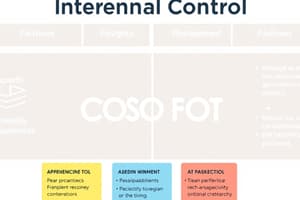Podcast
Questions and Answers
What is internal control?
What is internal control?
Internal control is a system or procedures designed to manage risk, ensure compliance with laws and regulations, and achieve objectives within an organization.
Which of the following are components of the internal control framework? (Select all that apply)
Which of the following are components of the internal control framework? (Select all that apply)
- Control Specifications (correct)
- Management Objectives (correct)
- Sampling Methodology (correct)
- Incident Management
Internal control is an end in itself.
Internal control is an end in itself.
False (B)
What is the primary purpose of implementing internal control?
What is the primary purpose of implementing internal control?
What are the three lines of defense in the internal control framework?
What are the three lines of defense in the internal control framework?
What does the internal control charter govern?
What does the internal control charter govern?
Internal control aims to provide reasonable assurance regarding the achievement of __________.
Internal control aims to provide reasonable assurance regarding the achievement of __________.
What should management do in case of any incident or malfunction affecting the internal control framework?
What should management do in case of any incident or malfunction affecting the internal control framework?
Who is responsible for implementing internal control measures?
Who is responsible for implementing internal control measures?
Flashcards are hidden until you start studying
Study Notes
Internal Control Overview
- Internal control is a set of measures responsible for ensuring the reliability of operations, financial reporting, and compliance with laws.
- It aims to provide reasonable assurance regarding the achievement of operational objectives and risk management.
- The effectiveness of internal controls is evaluated by management and the board of directors.
Key Components of Internal Control
- Clear Objectives: Internal control frameworks should have defined objectives to ensure orderly conduct and efficient resource use.
- Risk Management: Involves understanding, controlling, and protecting against risks that might threaten organizational assets.
- Reliability of Information: Ensures accuracy in financial statements and management reports.
- Regulatory Compliance: Adherence to laws, policies, and internal standards is crucial.
Internal Control Framework
- Built on the principle of the Three Lines of Defense:
- Operational management
- Risk management and compliance functions
- Internal audit
- Guided by an internal control charter, which establishes the framework and responsibilities.
Internal Control Processes
- Control activities must be selected and developed to mitigate risks effectively.
- Risk treatment measures must be implemented timely and thoroughly.
- The connection between organizational objectives and risk management is essential for success.
Internal Control Limitations
- Internal controls are not foolproof and may not cover all risks.
- They should be seen as a means to an end, rather than an end in themselves.
Internal Audit vs. Internal Control
- Internal Audit: Focuses on the evaluation effectiveness and efficiency of internal controls and processes.
- Internal Control: Refers to the actual systems and procedures designed to manage risk and ensure compliance.
Incident Management
- Crucial for alerting management to any dysfunctions or issues that might impact the organization negatively.
- Emphasizes the importance of a proactive approach to risk and incident identification.
Studying That Suits You
Use AI to generate personalized quizzes and flashcards to suit your learning preferences.




